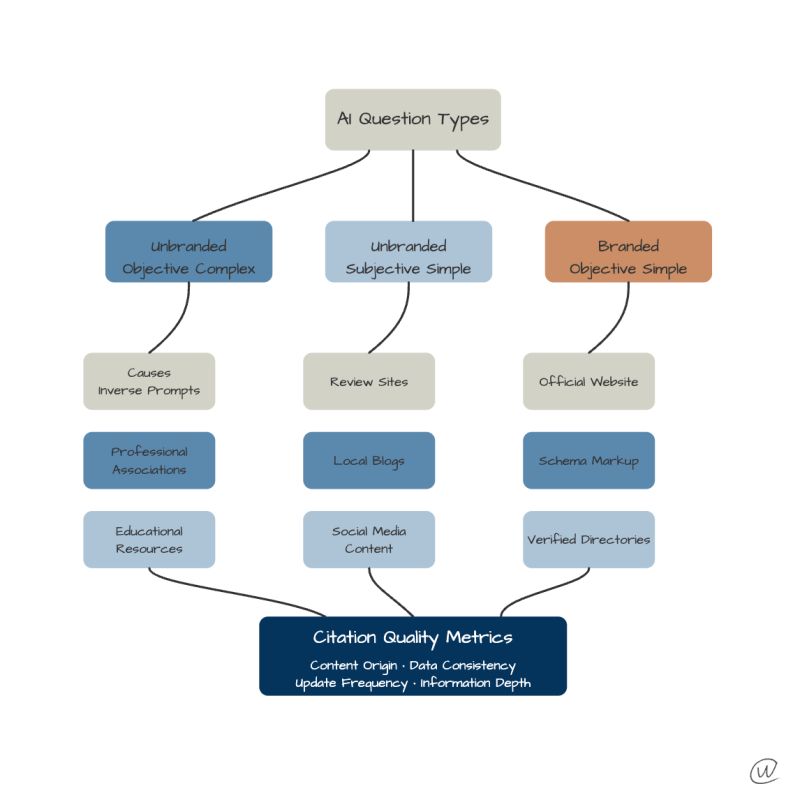
Key Insight
The questions we ask AI determine which citation sources matter. Different query types lead to different source preferences, creating a predictable pattern for content optimization. As search fragments across multiple AI platforms, businesses need a holistic approach to remain visible.
Research Source: This analysis is based on insights from a Duda webinar featuring CEO Itai Sadan and Yext CDO Christian Ward revealing the patterns behind AI's source selection process and the rapidly evolving search landscape.
📊The Evolution of Search
Search Fragmentation
AI platforms are becoming significant channels, with up to 25% of searches potentially moving to AI platforms.
Time Engagement
Users spend significant time with AI assistants, particularly for complex queries requiring multiple traditional searches.
Query Complexity
AI platforms excel at handling complex, multi-part questions that traditional search struggles with.
Platform Adoption
ChatGPT, Grok, Perplexity, and other AI platforms challenging Google's traditional dominance.
We're witnessing a fundamental shift in how people find information. While Google has dominated search for decades, the rise of AI platforms is creating the most significant disruption since the advent of mobile search. This isn't just about new technology – it's about a complete transformation in how users engage with information.
🎯The Three Core Query Paths
AI systems follow three primary query paths when selecting citation sources. Each path has distinct characteristics and preferred source types:
1. Unbranded, Objective, Complex
Primary Sources:
2. Unbranded, Subjective, Simple
Primary Sources:
3. Branded, Objective, Simple
Primary Sources:
⚖️Citation Quality Metrics
AI evaluates all sources using four consistent measurements that align with Information Quality Theory (Wang & Strong, 1996):
1. Content Origin
Critical WeightThe credibility and authority of the source
Optimization Tips:
2. Data Consistency
High WeightAlignment across different platforms and sources
Optimization Tips:
3. Update Frequency
Medium WeightHow often the information is refreshed
Optimization Tips:
4. Information Depth
High WeightThe comprehensiveness of the content
Optimization Tips:
🏆E-E-A-T Principles in AI Search
In the AI era, Google's E-E-A-T principles (Expertise, Experience, Authoritativeness, Trustworthiness) become even more crucial. AI systems are increasingly sophisticated at evaluating content quality and source credibility.
Expertise
Demonstrate deep knowledge in your field through comprehensive, accurate content
Experience
Showcase real-world applications and practical insights
Authoritativeness
Build strong citations and references from respected sources
Trustworthiness
Maintain consistent, accurate information across all platforms
🎯Strategic Implementation: The Four Key Signals
To optimize for both AI ("Answer Engines") and traditional search, businesses need consistent, high-quality, structured data across four key areas:
Website
Authoritative, structured content (Schema, FAQs), fast performance, good UX
Listings
Accurate, complete, and consistent business information across all directories
Reviews
Essential for subjective queries and building trust signals
Social Media
Provides real-time signals and engagement opportunities
🔮Future Trends in AI Search
AI Gaining Agency
AI will gain more agency, enabling direct actions like booking appointments, making purchases, or scheduling services within conversation interfaces.
Shift from Ads to Offers
Traditional advertising will evolve into personalized "offers" leveraging AI's understanding of user context and history.
Memory & Personalization
AI platforms maintain memory of user preferences, leading to increasingly personalized results that fragment traditional rankings.
Search Experience Optimization
Focus shifting to optimizing the entire search experience across multiple platforms, emphasizing structured data over keywords.
⚡Critical Focus: Structured Data
Structured data is becoming increasingly important. Feeding AI models structured information (like Schema markup) is more efficient than relying on them to parse unstructured content. Make it easy for machines to understand your content while maintaining engaging human-readable presentation.
🚀Optimize for AI Citation Success
Understanding these query paths provides a clear framework for optimizing your digital presence. Position your content strategically to appear in AI responses effectively.
👨💻About the Author
Ben Tannenbaum
Ben Tannenbaum is the founder of Aiso, a marketing tech company helping brands be visible in AI responses. With expertise in AI search optimization and content strategy, Ben helps businesses adapt to the evolving landscape of AI-powered search.